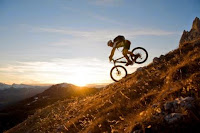Gears
In general the more gears a bike has the better but there is a point beyond which more gears will be helpful unless you are a pro-rider. I'm not a pro and I had to learn the hard way that gears are an important part of the bike and major factor in pricing.
Bike jargon definitions:

|
| Bike Diagram |
Drive Train
The entire assembly of gears (front and back) with the chain is referred to as the “drive train”.Cogset/Cassette
(I only remember this because of Lee Iacocca's Chrysler Comeback commercials about “drive train warranty”.)
The cogset is the stack of gears attached to the rear wheel of the bike. There are several ways of stacking and fixing the gears together; the most modern version is called a “cassette”.Crankset
The crankset are the front gears attached to the pedal arms which are (surprise!) called “cranks”.
Layout of the gears
Bikes may have 1, 2 or 3 gears in the front and 1, 6 to 10+ gears in the back.
- 3 gears are better than 1
- 6 gears are much better than 3
- 18 gears are way better than 6
- 21 gears are slightly better than 18
- 28+ gears – well, you probably won't need this and if you do, you'll be getting a different bike.
So the question you might ask is: “Why do I need so many?”
The answer is: You do and you don't.
Usable Gears
The fun part of cycling comes from the gears. It's all in the gears. Learning how to use the gears over different types of terrain is part of the fun but if you don't have the right gears for the terrain you are riding on; fun disappears quick.
So, you need the right number of gears for the terrain you are cycling on. If you are going up and down mountains that's a different ride than riding on a flat bike path.
Most bikes will come with a fixed set of gears, selected by the manufacturer as appropriate for that level, style and price of bike. You get what you get but you don't always get what you think you are getting.
Warning: a very loose explanation about gears.
Biking on the flat uses what I call the “sweet spot” set of gears. The bike chain will be in the middle gear in front and the middle gear in the back. Moving up or down from this spot makes it harder or easier to peddle.
When you go up a hill, you shift your gear into an easier to pedal one. You may go slower but you won't spend as much effort to get to the top.
When you go down a hill, you shift your gear into a harder to pedal one. This makes you go really fast downhill. You can also just coast down a steep hill and let gravity do the work for you.
The way the gears connect between the front and the back group, causes an overlap between some of the pairings. That overlap means that the total number of effective gears is less than the total number of gear combinations on the bike. This is so you don't have to make big gear changes as the terrain changes. It actually saves on the frequency of shifting. You still bike based on how easy/hard it seems to you but you don't have to flip the front/back combos as often.
Example from Wikipedia:
- A bicycle with 3 front gears and 8 back gears: the number of possible gear ratios is 24
(3×8 = 24, this is the number usually quoted in advertisements)
- the number of usable gear ratios is 22
- the number of distinct gear ratios is typically 16 to 18
When considering a bike, consider the terrain you want to ride on. Ask the bike pros about the gears and the number of usable gears you need for that type of terrain. Most specialty bike stores are familiar with the local terrain and many sponsor competitive bike teams in the various cycling sports and are familiar with all the ins and outs of gearing.
What you want is enough gears to keep it fun. Having more gears is way better than not having enough. Cycling up a hills without enough gears to select from isn't much fun. Going up hill is hard enough, going up hill without enough gears to make it to the top means you will be walking to the top of the hill.
For some odd reason, downhill isn't as much of an issue... WHEEEEEE!!!!
 |
| WHEEEEE! |
No comments:
Post a Comment